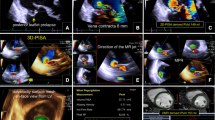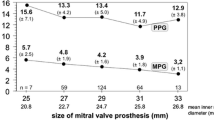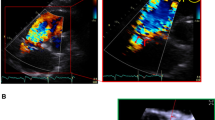Abstract
Background: Two-dimensional (2D) echocardiography planimetry, the Doppler pression half-time (PHT), and the continuity equation methods were used to estimate mitral valve area (MVA) in patients with mitral stenosis (MS). Recently, the proximal isovelocity surface area (PISA) method has been shown to be accurate for calculating MVA. The purpose of this study is (1) to compare in a large non-selected population the accuracy of the PISA and planimetry methods for echocardiographic estimation of MVA; (2) to determine the effect of atrial fibrillation (AF), Wilkins score, associated mitral regurgitation (MR), aortic regurgitation (AR), and of commissural calcifications on the accuracy of the PISA method. Methods: One hundred and eight consecutive patients with rheumatic MS were studied (76 females and 32 males; mean age: 36 ± 12 years); 64 were in sinus rhythm; 51 had associated MR and 46 had AR. By the PISA method, MVA was calculated assuming a uniform radius flow convergence region along a hemispherical surface. Results: The mean value of 2D MVA was 1.32 ± 0.59 cm2 (0.4–3.1 cm2) and that of PISA MVA 1.33 ± 0.62 cm2 (0.38–3 cm2). MVA calculated using the PISA method correlated well with 2D MVA (r = 0.93, y = 0.97x + 0.04, p < 0.0001, SEE = 0.21 cm2). The correlation was also good in patients with AF (r = 0.93, y = 0.99x + 0.03, p < 0.0001, SEE = 0.21 cm2), with MR (r = 0.94, y = 1.014x + 0.003, p < 0.0001, SEE = 0.19 cm2), with AR (r = 0.93, y = 0.90x + 0.11, p < 0.0001, SEE = 0.2 cm2), when Wilkins score was >8 (r = 0.92, y = 0.96x + 0.06, p < 0.0001, SEE = 0.19 cm2), and in patients with commissural calcifications (r = 0.90, y = 0.88x + 0.009, p < 0.0001, SEE = 0.20 cm2). Conclusion:Our study shows that in routine practice, MVA calculated by the PISA method correlated well with the area obtained by planimetry even in the presence of commissural calcifications, associated MR, AR, AF and of high Wilkins score. Therefore, the PISA method provides a reliable measurement of the MVA in MS under different anatomic and clinical conditions and may be a useful alternative method for calculating MVA.
Similar content being viewed by others
References
Henry WL, Griffith JM, Michaels LL, Mc Intich CL, Morrow AG, Epstein SE. Measurement of mitral orifice area in patients with mitral valve disease by real time twodimensional echocardiography. Circulation 1975; 51: 827–831.
Nichol PM, Gilbert BW, Kisslo JA. Two-dimensional echocardiographic assessment of mitral stenosis. Circulation 1977; 55: 120–128.
Martin RP, Rakowski H, Kleiman JH, Beaver W, London E, Popp RL. Reliability and reproductibility of two-dimensional echocardiographic measurement of the stenotic mitral valve area. Am J Cardiol 1979; 43: 560–568.
Smith MD, Handshoe R, Handshoe S, Kwan OL, De Maria AN. Comparative accuracy of two-dimensional echocardiography and Doppler pressure half-time methods in assessing the severity of mitral stenosis in patients with and without prior commissurotomy. Circulation 1986; 73: 100–107.
Nakatani S, Masuyama T, Kodama K, Katabatake A, Fuji K, Takenobu K. Value and limitations of Doppler echocardiography in the quantification of stenotic mitral valve area: comparison of the pressure half-time and the continuity equation methods. Circulation 1988; 77: 78–85.
Flachskampf FA, Weyman AE, Gillam L, Chun-Ming L, Abascal V, Thomas JD. Aortic regurgitation shortens Doppler pressure half-time in mitral stenosis. J Am Coll Cardiol 1990; 16: 396–404.
Karp K, Teien D, Bjerle P, Erikson P. Reassessment of valve area determination in mitral stenosis by the pressure halftime: impact of left ventricular stiffness and peak diastolic pressure difference. J Am Coll Cardiol 1989; 13: 594–599.
Thomas JD, Weyman AE. Doppler mitral pressure halftime: a clinical tool in search of theoretical justification. J Am Coll Cardiol 1987; 10: 923–929.
Rodriguez L, Thomas S, Monterroso V, Weyman AE, Horrigan P, Mueller LN. Validation of the proximal flow convergence method: calculation of orifice area in patients with mitral stenosis. Circulation 1993; 88: 1157–1165.
Utsunomiya T, Ogawa T, Tang HA, Henry WL, Gardin JM. Doppler color flow mapping of the proximal isovelocity surface area: a new method for measuring volume flow rate across a narrowed orifice. J Am Soc Echocardiogr 1991; 4: 338–348.
Rifkin R, Harper K, Tighe D. Comparison of proximal isovelocity surface area method with pressure half time and planimetry in evaluation of mitral stenosis. J Am Coll Cardiol 1995; 26: 458–465.
Miyatake K, Izumi S, Okamoto M. Semiquantitative grading of severity of mitral regurgitation by real time two dimensional Doppler flow imaging technique. J Am Coll Cardiol 1986; 7: 82–88.
Bland JM, Altman DG. Statistical methods for assessing agreement between methods of clinical measurement. Lancet 1986; 1: 307–310.
Utsunomiya T, Doshi R, Patel D, Mehta K, Nguyen D, Henry W. Calculation of volume flow rate by the proximal isovelocity surface area method: simplified approach using color Doppler zero baseline shift. J Am Coll Cardiol 1993; 22: 277–282.
Shandas R, Gharib M, Liepmann D, Shiota T, Sahn DJ. Experimental studies to define geometry of the flow convergence region. Echocardiography 1992; 9: 43–50.
Flachskampf FA, Weyman AE, Guerrero JL, Thomas J. Calculation of atrioventricular comliance from the mitral profile: analytic and vitro study. J Am Coll Cardiol 1992; 19: 998–1004.
Utsunomiya T, Ogawa T, Doshi R, Patel D, Quan M, Henry W. Doppler color flow proximal isovelocity surface area method for estimating volume flow rate: effects of the orifice shape and machine factors. J Am Coll Cardiol 1991; 17: 1103–1111.
Shiota T, Jones M, Valdez-Cruz L, Schandas R, Yamada I, Sahn D. Color flow Doppler determination of transmitral flow orifice area in mitral stenosis: experimental evaluation of the proximal flow convergence method. Am Heart J 1995; 129: 114–123.
Yoganathan A, Cape E, Sung HW, Williams FP, Jimoh A. Review of hydrodynamic principles for the cardiologist: application to the study of blood and jet by imaging techniques. J Am Coll Cardiol 1988; 12: 1344–1353.
Deng Y, Matsumoto M, Wang X, Liu L, Takizawa S, Takekoshi N. Estimation of mitral valve area in patients with mitral stenosis by the flow convergence region method: selection of the aliasing velocity. J Am Coll Cardiol 1994; 24: 683–689.
Vandervoort PM, Rivera JM, Mele D. Application of color Doppler flow mapping to calculate effective regurgitant orifice area: an in-vitro study and initial clinical observations. Circulation 1993; 88: 1150–1156.
Degertekin M, Basaran Y, Gencbay M, Yaymaci B, Dindar I, Turan F. Validation of flow convergence region method in assessing mitral valve area in the course of transthoracic and tranoesophageal echocardiographic studies. Am Heart J 1998; 135: 207–214.
Nishimura RA, Rihal CS, Tajik J, Holmes D. Accurate measurement of transmitral gradient in patients with mitral stenosis: a simultaneous catheterization and Doppler echocardiographic study. J Am Coll Cardiol 1994; 24: 152–158.
Carabello BA. Advances in the hemodynamic assessment of stenotic cardiac valves. J Am Coll Cardiol 1987; 10: 912–919.
Smith MD, Handshoe R, Handschoe S, Kwan OL, De Maria AN. Comparative accuracy of two-dimensional echocardiography and Doppler pressure half-time methods in assessing severity of mitral stenosis in patient with and without prior commissurotomy. Circulation 1986; 73: 100–107.
Author information
Authors and Affiliations
Rights and permissions
About this article
Cite this article
Bennis, A., Drighil, A., Tribouilloy, C. et al. Clinical application in routine practice of the proximal flow convergence method to calculate the mitral surface area in mitral valve stenosis. Int J Cardiovasc Imaging 18, 443–451 (2002). https://doi.org/10.1023/A:1021197022688
Issue Date:
DOI: https://doi.org/10.1023/A:1021197022688




